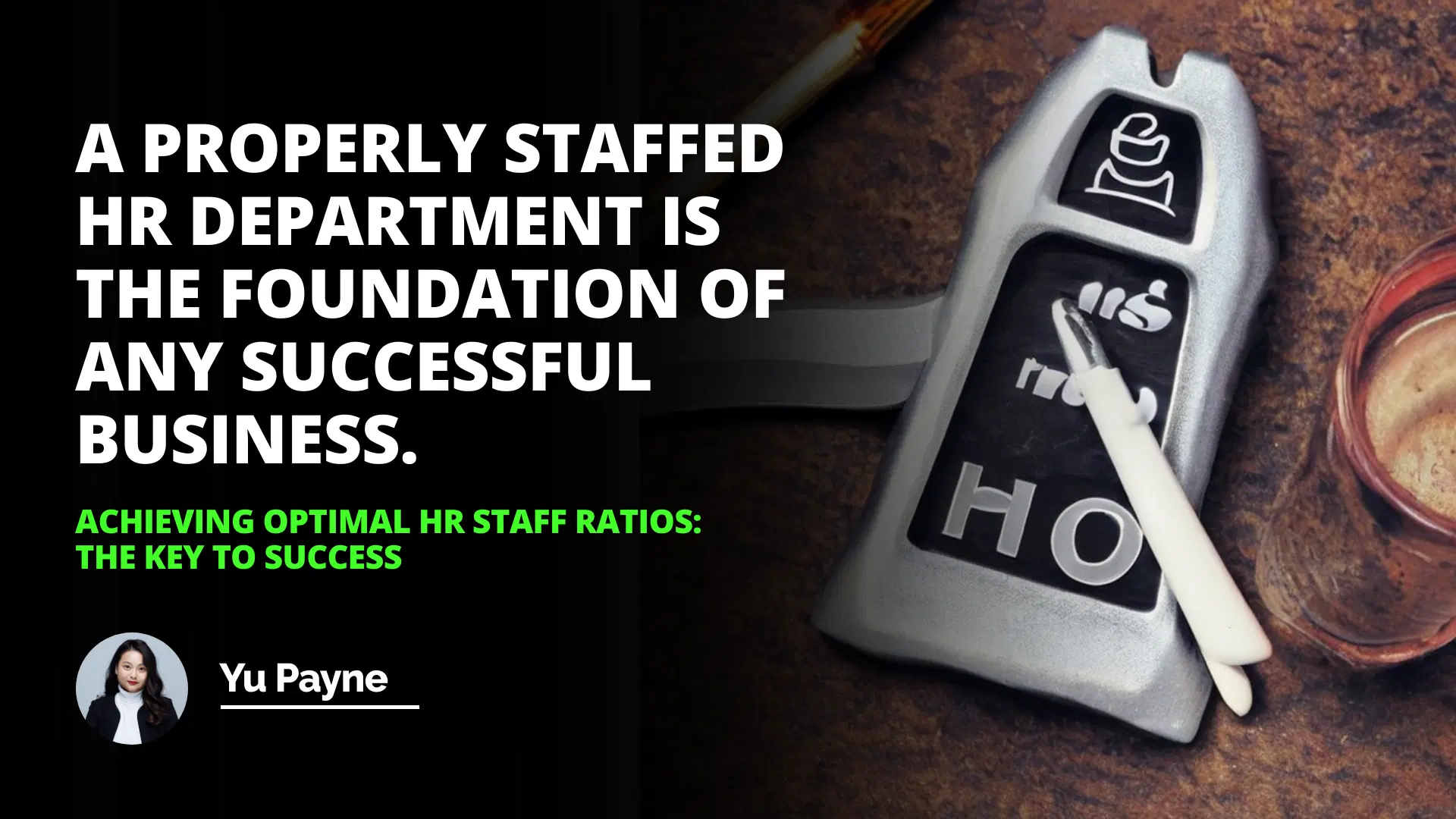
I remember when I first stepped into the bustling office of a mid-sized tech company a few years ago. The energy was palpable, with teams collaborating on innovative projects. But as I delved deeper into my role in human resources, I noticed something amiss. The HR team was overwhelmed, juggling countless tasks without adequate support. This imbalance impacted not just the HR department, but the entire organization. It became clear to me that achieving optimal HR staff ratios isn't just a numbers game; it's pivotal for the health and success of any company.
Understanding the Importance of HR Staff Ratios
Optimal HR staff ratios refer to the ideal number of HR professionals relative to the total number of employees in an organization. This ratio ensures that the human resources team can effectively manage recruitment, training, employee relations, and compliance without burning out or dropping the ball.
The Personal Impact of Imbalanced Ratios
In my early days as an HR professional, I witnessed colleagues struggling to keep up with their workload. One afternoon, a fellow HR manager confided in me:
"I feel like I'm constantly firefighting. There's just not enough of us to handle the volume of work. Important tasks slip through the cracks, and we can't give our employees the attention they deserve."
This frustration isn't uncommon. When the HR for HR isn't prioritized, the entire organization can suffer.
Challenges of Achieving Optimal HR Staff Ratios
Navigating the path to optimal ratios isn't without obstacles. Let's delve into some of the significant challenges organizations face:
1- Cost Constraints
Investing in a robust human resource HR team requires financial commitment. For smaller companies or startups, allocating budget to expand the HR department can seem daunting.
2- Limited Access to Talent
Finding qualified HR human professionals isn't always easy. The demand for experienced HR personnel often outpaces supply, leading to stiff competition in the job market.
3- Operational Complexity
Even with sufficient staff, coordinating tasks and workflows can be a Herculean effort. Strategic HR management involves aligning HR functions with business goals, which requires both planning and agility.
4- Technological Adaptation
Integrating a human resource management information system demands both time and expertise. Without proper training, technology intended to streamline processes can instead become a hindrance.
Benefits of Optimal HR Staff Ratios
Despite the hurdles, achieving the right balance brings a multitude of advantages:
Enhanced Employee Engagement
When human resources teams can devote adequate time to employee development and well-being, it fosters a more engaged and motivated workforce.
Improved Compliance and Risk Management
Adequate staffing ensures that the company stays abreast of labor laws and regulations, reducing the risk of costly legal issues.
Increased Productivity
With optimal ratios, HR professionals can focus on strategic initiatives rather than merely reacting to problems, driving overall organizational performance.
Better Talent Acquisition and Retention
A well-resourced human resources services team can attract top talent and implement programs that keep employees satisfied and loyal.
Strategies for Achieving Optimal HR Staff Ratios
Addressing the challenges requires a multifaceted approach. Here are some strategies that have proven effective:
An adequately staffed HR department is the foundation of any successful business.
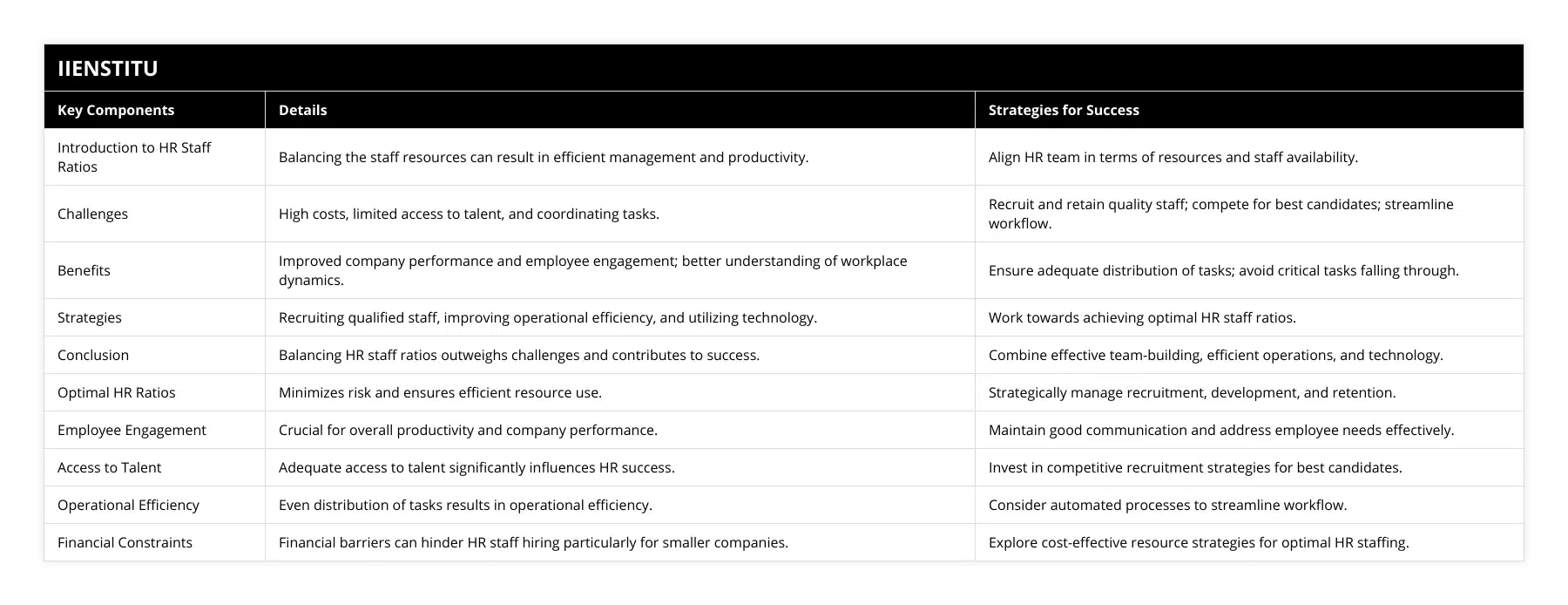
1. Assessing Organizational Needs
Conduct a thorough analysis of the company's size, industry, and growth projections.
Identify the specific HR functions that are critical for your business.
2. Investing in Technology
Implement a human resource management information system to automate routine tasks.
Utilize data analytics to make informed decisions about workforce planning.
3. Prioritizing HR Functions
Focus on strategic human resource management activities that align with business goals.
Outsource administrative tasks if necessary to external agencies or consultants.
4. Building a Strong HR Team
Recruit individuals with diverse skills and backgrounds to cover all aspects of HR.
Provide ongoing training and development opportunities to keep the team sharp.
5. Promoting Cross-Functional Collaboration
Encourage HR to work closely with other departments, enhancing understanding and efficiency.
Optimize supply chain management process tips can be applied to HR workflows to improve operations.
Real-World Example: Turning Challenges into Opportunities
At a previous company, we faced the daunting task of overhauling our human and resources department with limited funds. Rather than immediately hiring more staff, we:
1- Streamlined Processes
Underlined our priority areas and eliminated redundant tasks.
2- Leveraged Technology
Adopted an HR information system that automated payroll and attendance tracking.
3- Empowered Employees
Implemented self-service portals, reducing the administrative burden on HR.
These steps didn't just alleviate immediate pressures; they set the foundation for sustainable growth.
Conclusion
Achieving optimal HR staff ratios is more than balancing numbers; it's about creating a resilient and effective human resources framework that supports both employees and organizational goals. While challenges like cost barriers and talent shortages exist, strategic planning and innovation can overcome them.
Reflecting on my journey, I realize that the key lies in understanding the unique needs of your organization and being willing to adapt. By investing in strategic HR management, embracing technology, and fostering a collaborative environment, companies can build an HR team that not only manages but thrives.
Remember, an adequately staffed HR department isn't just a cog in the machine; it's the heartbeat of a successful business. So, take the time to assess, plan, and invest in your resources HR wisely.
References
Dessler, G. (2017). Human Resource Management (15th ed.). Pearson Education.
Ulrich, D., & Brockbank, W. (2005). The HR Value Proposition. Harvard Business Press.
Armstrong, M. (2012). Armstrong's Handbook of Human Resource Management Practice (12th ed.). Kogan Page.
Becker, B., & Huselid, M. (2006). The Workforce Scorecard: Managing Human Capital To Execute Strategy. Harvard Business Review Press.
Note: The above content is based on personal experiences and well-established principles in the field of human resources. For further reading, please refer to the listed academic sources.
Frequently Asked Questions
What is the ideal staff-to-employee ratio and why is it important to maintain?
Maintaining an ideal staff-to-employee ratio is essential for any company, regardless of size or industry. Achieving the perfect balance of personnel duties and tasks is critical to maximizing productivity, minimizing frustration, and ensuring employee job satisfaction. The ratio of staff to employees should be tailored to the unique needs of the organization as well as the complexities of the specific job or roles.
When analyzing the ideal staff-to-employee ratio, three main criteria should be taken into consideration: roles and responsibilities, workload, and employee satisfaction. The roles and responsibilities should be assessed against the specific requirements of the job and the amount of work required to complete them. Prioritizing the tasks and assigning staff members accordingly is essential for ensuring that the workload is evenly distributed among the staff. This, in turn, can help reduce stress and increase employee job satisfaction.
Additionally, the staff-to-employee ratio should be adjusted to address changing demands or business goals. For example, if an organization is expanding or entering a new market, there may be an increase in the workload, and therefore more staff should be brought on board to help meet the demands. Additionally, adjusting the ratio can help improve service delivery, as more staff members might be assigned to customer-facing roles, leading to better customer experiences.
Finally, it is essential to maintain the ideal staff-to-employee ratio as it can significantly impact employee morale and performance. If the staffing levels are insufficient, it can lead to dissatisfaction and fatigue, as employees may be overworked while others are idle. Conversely, an excessive ratio can lead to inefficient use of resources and decreased proficiencies.
Overall, the ideal staff-to-employee ratio must be established and maintained to optimize productivity, ensure the delivery of high-quality services, and provide job satisfaction among employees. Therefore, companies should focus on finding the correct number of staff members to fulfill their needs and ensure that regular reviews are conducted to adjust to changing demands or business goals. Doing so can help create an encouraging and motivating environment for employees and ultimately help the organization succeed.
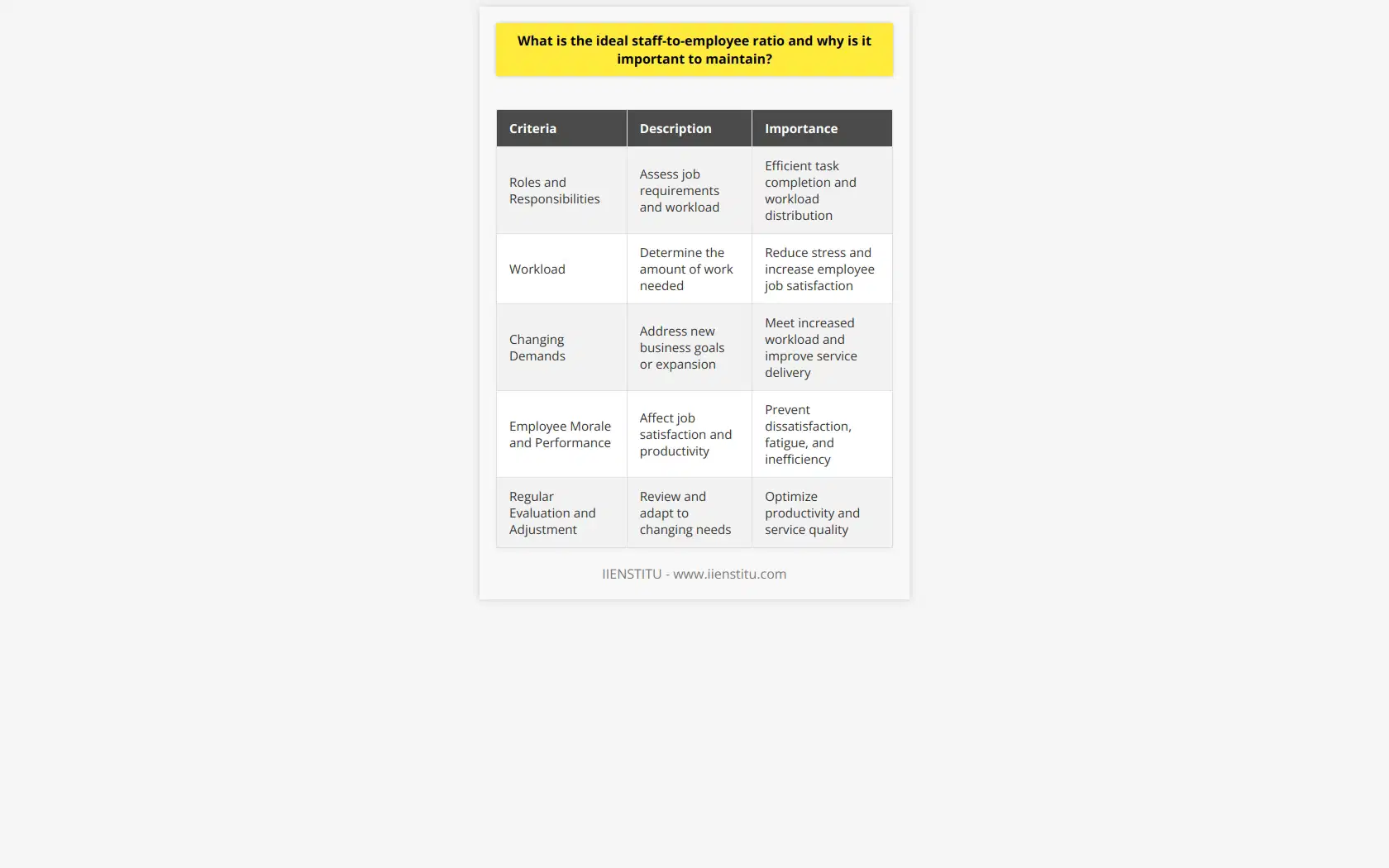
How can companies prioritize HR staff's tasks and maximize their productivity?
Employee engagement has become an increasingly important concern for employers in recent years. The need to maximize the productivity of human resources staff has become both an imperative, and a challenge, particularly as companies strive to provide an optimum workforce experience. To prioritize tasks and maximize productivity, companies should consider strategies such as implementing Human Resources Information Systems (HRIS), providing direction and feedback, establishing clear objectives and expectations, and leveraging technology.
HRIS provides an efficient means to prioritize tasks by helping companies capture and manage internal employee data. The system lets users control the employee life-cycle, including recruitment, onboarding, performance management, retention, etc. By noting employee preferences and work patterns, utilizing HRIS can ensure that employee tasks are completed promptly and efficiently.
In addition to using HRIS, employers should ensure that they provide staff with clear and timely direction and feedback. This may include assigning specific tasks, providing meaningful performance evaluations, setting deadlines, reviewing workloads, and addressing workload imbalances. Implementing individual development plans or providing mentoring or coaching opportunities is also valuable for companies to prioritize staff tasks and maximize productivity.
Furthermore, companies should strive to set measurable objectives and expectations that enable employers and employees to measure their progress in achieving desired outcomes. This may include developing articulated core values or job descriptions. With clear objectives and expectations, human resources staff can better prioritize tasks and measure performance against desired outcomes.
Finally, leveraging technology to maximize productivity is essential. For example, incorporating collaborative technology, such as instant messaging and employee portals, can facilitate a more efficient workflow. Furthermore, developing detailed job descriptions, creating electronic filing systems, and using automated tracking systems can all serve to optimize employee productivity.
In conclusion, companies must look at strategies to prioritize Human Resources staff’s tasks and maximize productivity. Implementing HRIS, providing direction and feedback, setting measurable objectives and expectations, and leveraging technology are critical steps in helping companies achieve this goal. By doing so, employers can ensure that their human resources staff can consistently reach their desired outcomes and optimize the experience for both employees and customers.
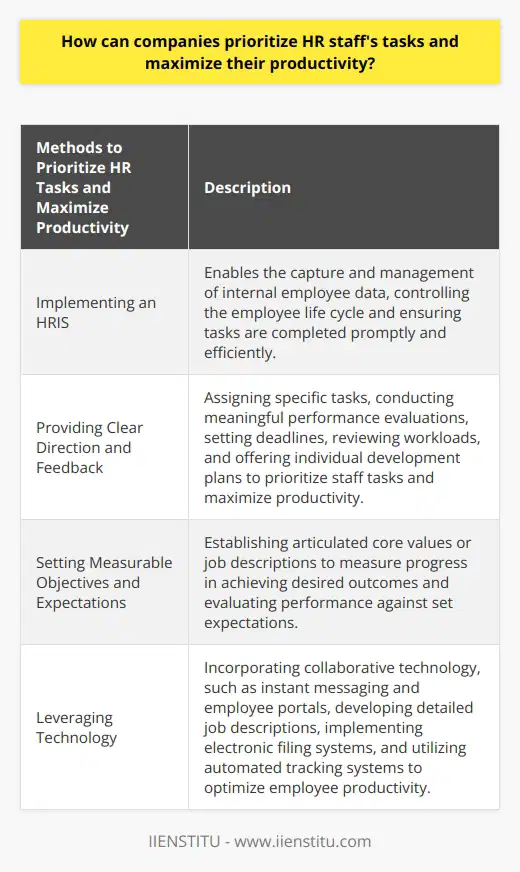
What technology or analytics can be used to ensure an organization is operating at an optimal HR staff ratio?
Employers use various technology and analytics to identify their organization's optimal human resource staff ratio. This ensures that productivity levels are maximized, and unnecessary costs are minimized.
At the most basic level, a human resources department can use a simple spreadsheet to track and analyze current staff numbers and the costs associated with their hiring, training, and salary. Then, by factoring in the number of applicants and forecasted workloads, employers can adjust the staffing ratio to meet their budget and timeline goals.
However, technology is also increasingly important in improving how organizations handle their HR staff ratios. Using data mining and predictive analytics, companies can identify inefficiencies in their current balances and optimize their staff numbers accordingly. Predictive analytics helps companies to forecast workloads, quantify the value of existing staff, and prioritize potential new hires. Data mining techniques can uncover the team-level trends needed to meet specific goals and objectives over time. Artificial intelligence can provide further insight into the optimal HR staff ratios by analyzing the data collected and suggesting proactive adjustments.
Organizations can also leverage modern workforce management software to track staff's workflows. This software helps managers determine the most productive staff ratios for their operations and equip employees with the tools necessary to complete their tasks. In addition, such tools can provide managers with visual representations of their standardized procedures, giving them an accurate overview of how their staffing needs match the current workloads.
In conclusion, technology and analytical tools are essential in today's business environment to ensure that the organization operates at the optimal HR staff ratio. Employers can use various tools, from simple spreadsheet data to advanced predictive analytics, to maximize efficiency and reduce unnecessary costs. In addition, by leveraging modern workforce management software, managers can gain insight into their current staff's quantitative and qualitative value and adjust accordingly.
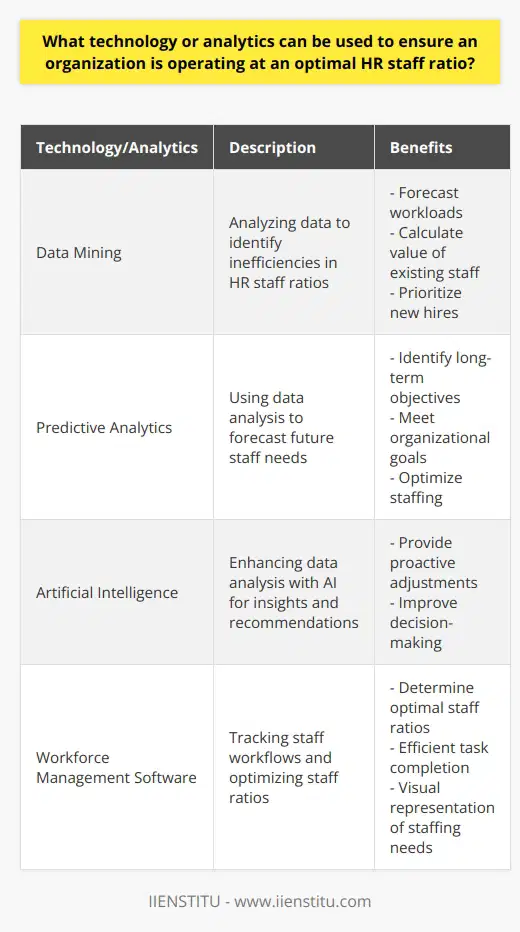
What factors should be considered when determining the optimal HR to employee ratio, and how does this impact organizational effectiveness?
HR to Employee Ratio Considerations
Determining the optimal human resources (HR) to employee ratio is crucial for organizational effectiveness. Multiple factors must be considered when making this decision. These factors can include the size of the organization, industry standards, the complexity of HR tasks, and the automation of HR processes. Understanding and weighing each factor ensures that companies maintain an effective HR presence, directly impacting their overall success.
Organizational Size
Organizations of different sizes require different HR to employee ratios. In general, larger organizations benefit from a lower HR staff to employee ratio since they can leverage economies of scale. Smaller organizations may need a higher ratio, as a smaller HR team may be insufficient in managing processes and addressing employee needs.
Industry Standards
Industry standards also play a role in determining the appropriate HR to employee ratio. Companies operating in industries with higher turnover rates might require a higher ratio to manage the constant influx of new employees. Comparing a company’s ratio with those of its competitors and industry benchmarks can offer valuable insights and help make informed decisions.
Complexity of HR Tasks
The complexity and demands of HR tasks within an organization can impact the required HR to employee ratio. When companies have highly specialized or regulated HR processes such as talent acquisition, strategic workforce planning, and compliance, they may need more HR professionals to effectively manage these processes. Conversely, organizations with simpler and more straightforward HR operations may require fewer staff members.
Automation of HR Processes
Incorporating technology and automation into HR processes can significantly impact the optimal HR to employee ratio. For instance, automating repetitive tasks such as data entry or benefits administration can help decrease HR workload and reduce the number of HR professionals needed. However, organizations should carefully balance the benefits of automation with the potential loss of personal touch and employee engagement in HR processes.
Impact on Organizational Effectiveness
By considering the factors mentioned above, organizations can determine their optimal HR to employee ratio. This decision can greatly impact an organization's effectiveness as it directly influences critical aspects such as employee satisfaction, productivity, talent acquisition and retention, and compliance with regulations. As such, the optimal HR to employee ratio should promote the achievement of business objectives and ensure the overall success of the organization.
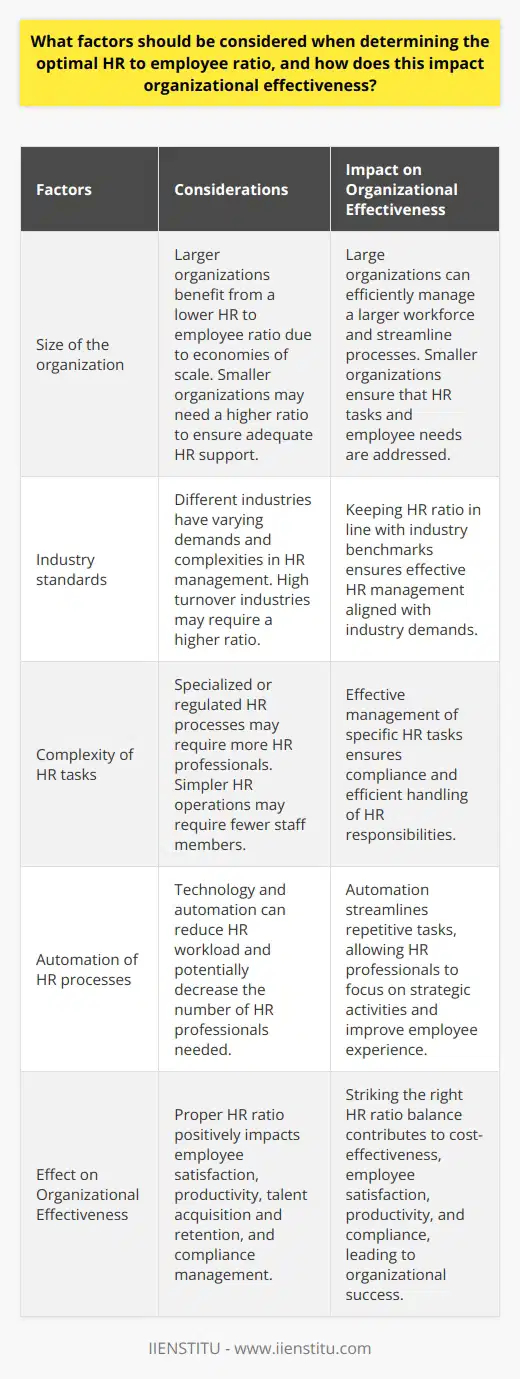
How does an organization's size and structure influence HR metrics and staff ratios, and what are the potential consequences?
Organizational Size and Structure Impact on HR Metrics
The size and structure of an organization considerably influence HR metrics and staff ratios, as they determine the complexity and efficiency of HR processes. In a large organization with a hierarchical structure, multiple levels of management and diversified job roles make HR functions more convoluted. Consequently, these companies may have a higher employee-to-HR-staff ratio, meaning fewer HR personnel per employee, as it becomes cumbersome and resource-intensive to maintain a lower ratio.
Influence on Recruitment and Retention
Large organizations often face greater challenges in recruitment and retention. For instance, competition for talent can be fierce, leading to higher recruitment costs and longer time-to-fill metrics. Additionally, more significant attrition rates are commonplace in such companies, possibly contributing to costly turnover and reduced employee engagement. Thus, HR professionals within large companies must be adept at handling these issues efficiently to maintain long-term workforce stability.
Training and Development Needs
Another consequence arises in the form of training and development needs. Large organizations require more extensive and often tailored employee development programs to ensure skillsets remain relevant and up-to-date. These programs typically involve higher costs and resources, leading to increased pressure on the HR department to deliver value for the investment. Smaller firms, on the other hand, may require less rigorous training strategies due to the reduced scope and diversity of roles.
Effect on Performance Management
Performance management is another area affected by organization size and structure. In large organizations, it is essential to have robust systems in place for tracking employee goals, performance appraisals, and feedback mechanisms. This requires significant investment in technology and tools, as well as a well-defined and effective HR strategy. In comparison, smaller firms may be able to manage performance through direct communication and simplified systems.
In conclusion, an organization's size and structure significantly impact HR metrics and staff ratios, shaping the functions and resources required to manage the workforce efficiently. Larger companies with multi-layered structures face more considerable challenges in recruitment, retention, training and development, and performance management. Addressing these issues effectively necessitates strategic planning, allocation of resources, and the implementation of robust policies by HR professionals.
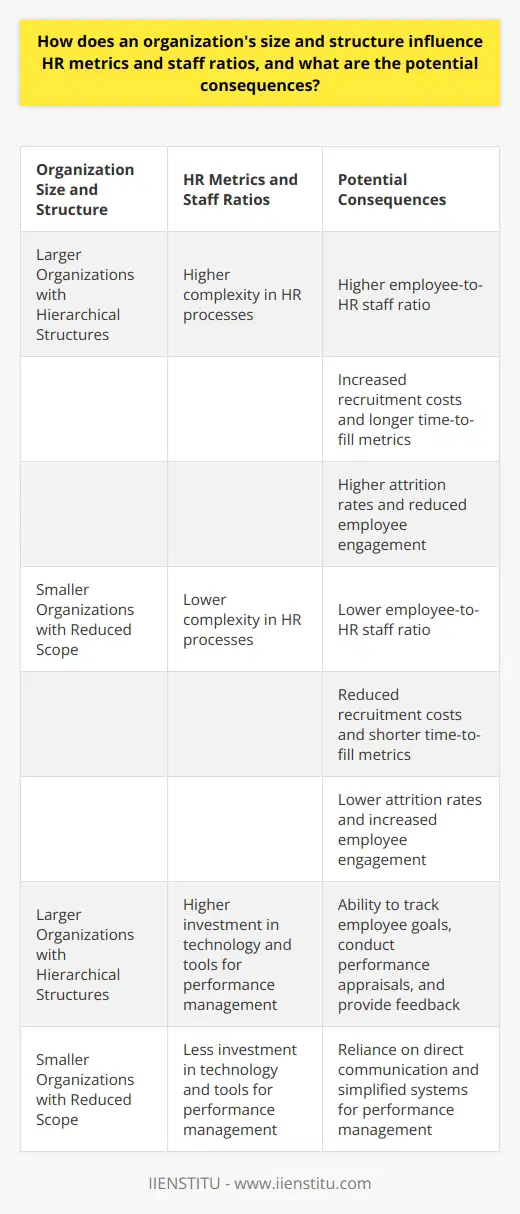
What strategies can organizations employ to optimize their HR to FTE ratio, and how can they evaluate its effectiveness?
**Strategic Workforce Planning**
Organizations can optimize their human resources (HR) to full-time employee (FTE) ratio by implementing strategic workforce planning. This involves identifying the skills and competencies required to achieve organizational goals and aligning them with HR strategies.
**Recruitment and Selection**
Organizations can adopt targeted recruitment and selection practices, focusing on hiring candidates with skills matching the desired competencies. By using data-driven techniques, such as analytics and artificial intelligence, HR managers can assess candidates' skills and cultural fit more accurately.
**Training and Development**
Continuous training and development programs can enhance employees' skills and knowledge, enabling them to adapt to changing business environments. Personalized learning paths and growth-oriented performance management systems ensure employees are aligned with company objectives and maintain optimal FTE ratios through improved competence.
**Retention and Succession Planning**
Employee retention is crucial to maintain optimal HR to FTE ratios. Implementing retention strategies, such as competitive compensation, work-life balance initiatives, and career advancement opportunities, can reduce employee attrition rates. Additionally, succession planning allows organizations to identify and develop high-potential employees for future leadership roles, ensuring a steady talent pipeline.
**Flexible Workforce**
Organizations can adapt to fluctuating demands and resources by adopting flexible workforce models, such as contract positions, freelancers, and part-time employees. This approach allows companies to maintain a lean and efficient workforce while quickly scaling up or down depending on business needs, optimizing the HR to FTE ratio.
**Evaluating Effectiveness**
Metrics for evaluating the effectiveness of HR to FTE optimization strategies include:
*Employee productivity*: Organizations can examine output per employee to determine the efficiency of HR to FTE ratio management.
*Turnover rate*: A lower employee turnover rate indicates a successful implementation of retention strategies, contributing to a healthier HR to FTE ratio.
*Time to fill vacancies*: The ability to quickly recruit and onboard employees with the necessary skills reflects effective workforce planning and impacts the HR to FTE ratio.
*Employee satisfaction*: Engaged and satisfied employees are more productive, positively influencing the HR to FTE ratio. Employee engagement surveys and regular feedback can gauge satisfaction levels.
*Skill gap analysis*: Assessing the gap between required skills and employees' competencies helps identify areas for improvement, demonstrating the impact of training and development initiatives.
In conclusion, optimizing the HR to FTE ratio involves aligning workforce strategies with organizational goals, investing in recruitment, training and development, retention and succession planning, and adopting flexible workforce models. Regularly monitoring key metrics ensures the effectiveness of these strategies, resulting in a more productive and engaged workforce.
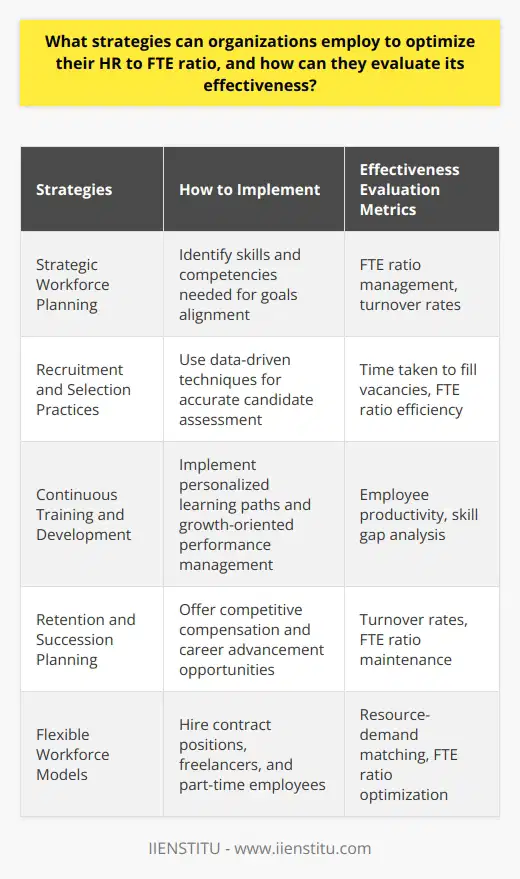
What is the optimum HR to employee ratio, and how does it vary across industries and organization sizes?
Optimum HR to Employee Ratio
The optimum Human Resource (HR) to employee ratio is a critical factor for organizational efficiency and effectiveness. This ratio is defined as the number of HR staff members per employee within an organization. While there isn't a one-size-fits-all approach to determining the ideal HR to employee ratio, various factors influence the optimal ratio, such as the nature of the industry and the size of the organization.
Industry Influences
Different industries have unique HR requirements that affect the optimal HR to employee ratio. For instance, industries such as manufacturing or construction may require a higher HR to employee ratio due to the increased need for workforce management, safety regulations, and labor-intensive processes. On the other hand, industries like technology or professional services may demand a lower HR to employee ratio, as they often involve less physical labor and less rigid regulatory requirements.
Organization Size
The size of the organization also plays a significant role in determining the optimal HR to employee ratio. In smaller organizations, with fewer than 50 employees, the HR to employee ratio may be higher, as one HR representative could efficiently manage HR functions. However, as an organization grows and crosses the 50-employee threshold, the ratio is likely to decrease. For instance, organizations with 50 to 200 employees may require a ratio of 1:50 (one HR representative for every 50 employees), while larger organizations may demand a 1:100 ratio or even lower. It is essential to strike a balance that ensures effective HR service delivery while minimizing HR personnel costs for the organization.
Customizing the Ratio
Each organization should customize its HR to employee ratio by considering its unique business goals, culture, and workforce requirements. Companies with a high degree of workforce turnover, for example, may need more HR staff to manage recruitment and onboarding processes. Furthermore, organizational structure, technology adoption, and HR automation also influence the optimal HR to employee ratio. Implementing technology solutions that automate HR processes and streamline key HR functions can reduce the need for additional HR staff members.
Conclusion
In summary, the optimum HR to employee ratio varies across industries and organization sizes, influenced by factors such as workforce management needs, regulatory requirements, and the overall business environment. It is crucial for organizations to assess their specific requirements and adapt their HR ratio accordingly. This assessment will contribute to improved HR service delivery, employee satisfaction, and overall organizational success.
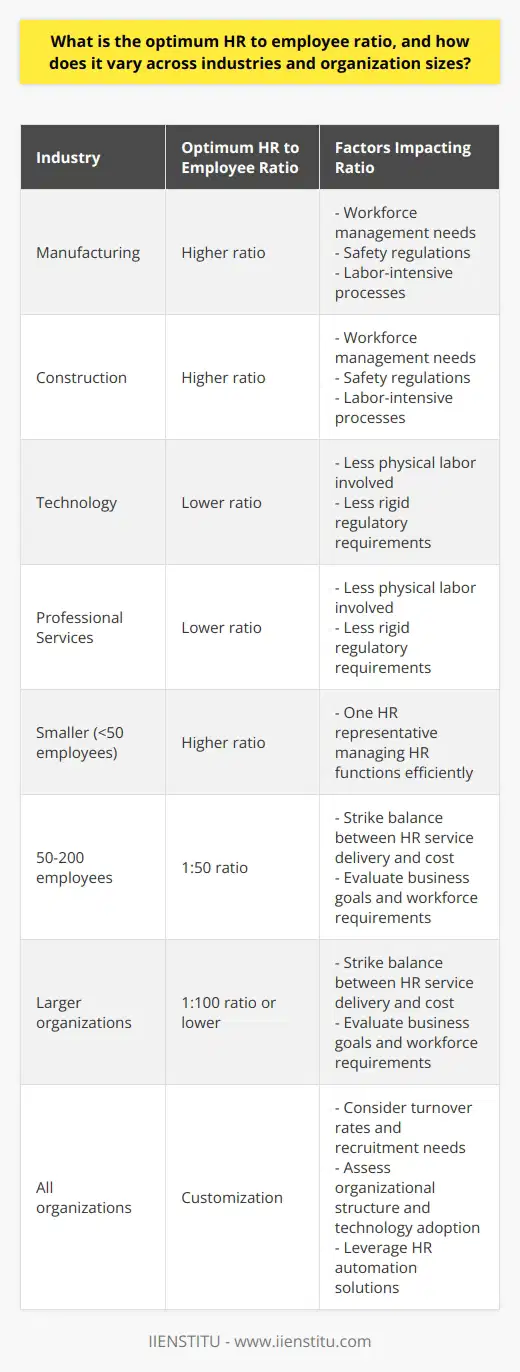
How can HR expense to FTE ratio be utilized as a metric for human resources efficiency and effectiveness?
Efficiency and Effectiveness Benefits
The HR expense to Full-Time Equivalent (FTE) ratio serves as a valuable metric in assessing human resource efficiency and effectiveness. By comparing the total cost of HR activities to the number of full-time employees in an organization, this ratio provides insights into how well HR functions operate. As such, a lower ratio implies a more efficient HR department, while a higher ratio may indicate excess spending or inefficiencies.
Resource Allocation
Firstly, the HR expense to FTE ratio ensures better resource allocation within the HR department. Through continuous monitoring of this metric, organizations can accurately identify where to invest or reduce budgetary expenses. This cost-driven approach is crucial in optimizing resource usage and aligning the HR department's objectives with overall business goals.
Operational Efficiency
Secondly, analyzing the HR expense to FTE ratio enables organizations to attain operational efficiency by identifying inefficient processes and systems. By addressing underutilized technology, duplicative tasks, or extraneous employee training, HR teams can streamline operations and improve overall performance. Streamlined HR processes not only reduce expenses and FTE requirements but also enhance employee satisfaction and retention rates.
Benchmarking and Industry Comparison
Lastly, the HR expense to FTE ratio offers a useful benchmark to compare an organization's HR performance with industry standards. As organizations become more cognizant of their HR costs in relation to full-time employees, they can measure their performance against peers and identify best practices. This industry comparison can facilitate the implementation of strategic HR initiatives that drive productivity, reduce costs, and ensure competitiveness.
Conclusion
In conclusion, monitoring the HR expense to FTE ratio is essential in evaluating human resource efficiency and effectiveness. By enabling better resource allocation, promoting operational efficiency, and serving as a benchmark for industry performance, this metric ultimately contributes to the continuous improvement and success of an organization's HR department.

How many employees do you need to have in an organization before implementing a dedicated human resources department or function?
Ideal Number of Employees for HR Implementation
There is no fixed number of employees necessary for the implementation of a dedicated human resources (HR) department or function within an organization. Nonetheless, it is crucial to consider various factors that may influence this decision.
Organizational Size and Complexity
First and foremost, the size and complexity of an organization play a significant role in determining the need for an HR department. Generally, smaller organizations with less than 50 employees may not require a dedicated HR function. Instead, they may rely on managers or business owners to handle HR duties. On the other hand, organizations with more than 50 employees typically benefit from a dedicated HR function. This helps manage the complexities resulting from an increased number of employee relationships, regulations, and policies.
Industry and Legal Requirements
The industry and legal requirements of a business may also impact the need for HR implementation. Organizations operating within heavily regulated industries like healthcare or finance may require HR support regardless of their size. This is because meeting regulatory compliance and handling employee licensure and certification may necessitate dedicated HR personnel.
Growth and Scaling
Another critical factor in deciding the need for a dedicated HR function is the organization's growth rate and scaling plans. Fast-growing companies aiming to expand their workforce rapidly should invest in HR early in the process. This ensures the efficient management of personnel issues and helps create a solid infrastructure for further expansion.
Company Culture and Values
Last but not least, the company's culture and values may impact the decision to establish an HR department. Businesses that place a high emphasis on employee engagement, well-being, and development may opt to introduce HR functions even with a smaller workforce. This helps ensure a strong foundation for their organizational ethos.
In conclusion, the decision to implement a dedicated HR function revolves around an organization's size, complexity, industry, growth plans, and culture. While there is no predetermined employee count at which HR becomes essential, considering these factors will aid organizations in making an informed decision based on their specific needs.
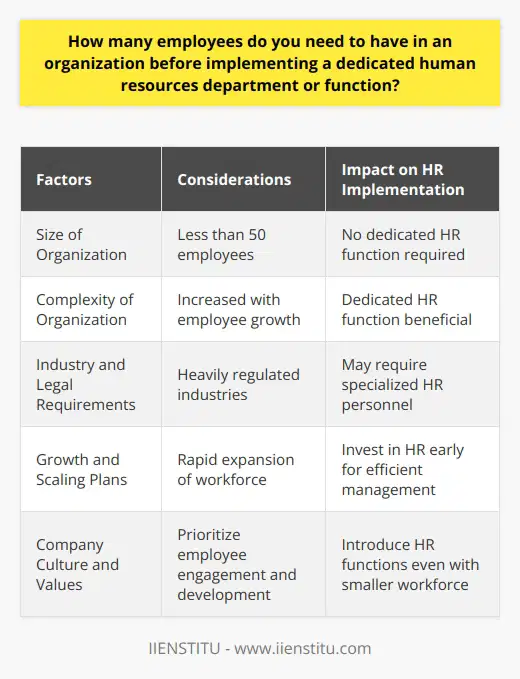
What is the key to success in HR, and how can organizations leverage it to achieve a competitive advantage?
Essential Skills for HR Success
The key to success in human resources (HR) is a combination of exceptional interpersonal and technical skills, which enable HR professionals to navigate the complexities of optimizing organizational performance. By possessing these skills, HR personnel can contribute significantly to an organization's competitive advantage.
Emphasis on Soft Skills
Arguably, the most critical soft skills for HR success include communication, listening, empathy, and problem-solving. Effective communication allows HR professionals to convey essential information and establish strong relationships with employees, thus fostering trust and promoting a positive work environment. Active listening enables a deeper understanding of staff concerns, ultimately making it easier to address their needs and provide feedback. Empathy drives HR personnel to treat employees with respect, ensuring they feel valued and appreciated. Finally, problem-solving skills are necessary for resolving conflicts, managing change, and making informed strategic decisions that impact an organization's long-term success.
Importance of Technical Skills
In addition to soft skills, HR professionals should also possess strong technical skills in HR-related areas such as recruitment, training, compensation, employee relations, and performance management. These technical skills allow HR personnel to effectively execute tasks, manage organizational processes and enable data-driven decision-making. Human resource information systems (HRIS) proficiency, coupled with data analytics, can provide an added benefit by allowing HR professionals to track, analyze, and interpret data related to overall workforce performance, demographics, onboarding, and talent management. This strategic use of data helps to identify areas for improvement, spotlight best practices, and influence decision-making that ultimately supports the organization's competitive advantage.
Leveraging HR for Competitive Advantage
Organizations can leverage HR success to achieve a competitive advantage by investing in the continuous development of their HR professionals. This can be achieved through targeted training programs, workshops, certifications, and mentoring opportunities. By ensuring HR personnel are equipped with the necessary skills and current industry best-practices, organizations can effectively respond to evolving workforce trends and adapt to the dynamics of their operating environment.
Moreover, organizations must promote a culture of collaboration between HR and other departments, ensuring that human resources initiatives are aligned with overall business objectives. When HR professionals connect their work with key organizational goals, they are more likely to contribute proactively to critical decisions and support the organization's long-term success.
In conclusion, mastering a blend of exceptional interpersonal and technical skills is the key to success in HR. Organizations that prioritize HR development and promote a culture of collaboration can maximize their chances of attaining a competitive advantage in today's complex and fast-paced business landscape.
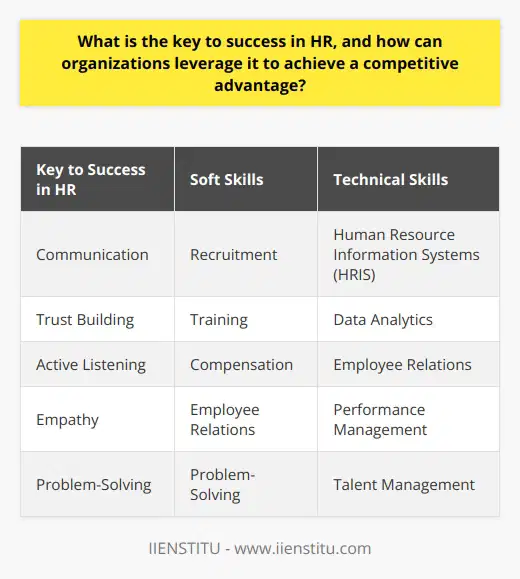
How do you measure the success of an HR team, and what metrics or benchmarks should be utilized to ensure continuous improvement?
Measuring Success of HR Teams
One approach to measuring the success of an HR team entails evaluating their performance based on key performance indicators (KPIs) that align with organizational goals. To ensure continuous improvement, these KPIs should be supported by specific metrics and benchmarks.
Employee Retention and Turnover
A crucial indicator of an HR team's success is employee retention and turnover rates. Adept HR teams ensure the organization maintains a low turnover rate and retains top talent through effective talent management strategies. Metrics used to evaluate this aspect include the average length of employee tenure and voluntary turnover rate.
Talent Acquisition Time and Quality
Another essential KPI is the efficiency and effectiveness of the talent acquisition process. Assessing the time it takes to fill open positions and the quality of hired employees is crucial in determining the HR team's competency. Metrics to measure this include time-to-fill, and quality of hire determined through performance reviews and employee contributions to the company.
Employee Satisfaction and Engagement
HR teams that foster satisfied and engaged employees contribute significantly to the organization's success. Employee engagement surveys and satisfaction scores help measure these aspects. Feedback mechanisms that evaluate employee happiness and commitment levels provide valuable insights into the effectiveness of HR initiatives.
Training and Development Programs
Successful HR teams create ample learning and development opportunities for employees. Monitoring employee development through training completion rates, skill advancement, and promotions highlights the impact of the HR team on the workforce. Evaluating the return on investment (ROI) for training and development programs can serve as an effective benchmark.
Compliance and Legal Issues
Preventing and addressing compliance and legal matters is a vital responsibility of HR teams. A successful team minimizes the number of employment-related disputes, such as discrimination cases, wage disputes, and workplace safety concerns. The number and severity of incidents that occur within a given period serve as key measures for this aspect.
In conclusion, measuring the success of an HR team encompasses evaluating various KPIs, such as employee retention, talent acquisition, employee satisfaction, training and development programs, and compliance management. Regular assessments of these performance indicators using metrics and benchmarks help ensure continuous improvements and maintain the HR team's effectiveness within the organization.

How do you optimize HR efficiency, incorporating technology and strategic planning, to create a more effective and streamlined human resources department?
Effective HR Processes
Optimizing HR efficiency involves a combination of well-defined processes, technology integration, and strategic planning that aligns with overall organizational goals. This ensures a streamlined human resources department that contributes significantly to the success of the company.
Strategic HR Data Analysis
Data analysis plays a critical role in driving HR decision-making. By implementing advanced analytics tools and utilizing big data, HR teams gain a comprehensive understanding of the workforce and identify areas for improvement. Data-driven insights can inform talent acquisition, employee engagement, and other critical HR functions.
Integration of HR Technology
Incorporating technology into HR processes is essential for boosting efficiency. Tools such as applicant tracking systems, HR management software, and e-learning platforms facilitate streamlined workflows, enabling HR professionals to focus on strategic activities. Automation of repetitive tasks, such as timekeeping and payroll management, further contribute to increased HR efficiency.
Talent Management Strategies
Optimizing HR efficiency requires strategic talent management initiatives that cater to attracting, retaining, and developing employees. Designing comprehensive onboarding programs, offering continuous professional development opportunities, and implementing transparent performance appraisal systems reinforce employee engagement and productivity.
Performance-Based Incentives
Implementing performance-based incentives aligns employee efforts with organizational objectives. Rewarding employees based on their performance not only encourages commitment and productivity but also aids in retaining top talent. HR teams must establish clear evaluation criteria and develop an effective system for tracking and measuring performance to enhance the impact of incentive programs.
Collaboration & Communication
Promoting a collaborative and communicative work environment is crucial for fostering a more efficient human resources department. Encouraging open dialogue and sharing ideas can boost employee morale and drive continuous improvement. Leveraging digital communication tools can further enhance team collaboration and simplify the flow of information.
In conclusion, the optimization of HR efficiency demands a holistic approach that merges strategic planning, technology adoption and thorough data analysis. Ensuring that the HR department is well-aligned with other business units and actively involved in achieving overarching organizational objectives enables the creation of a more effective and streamlined HR function.
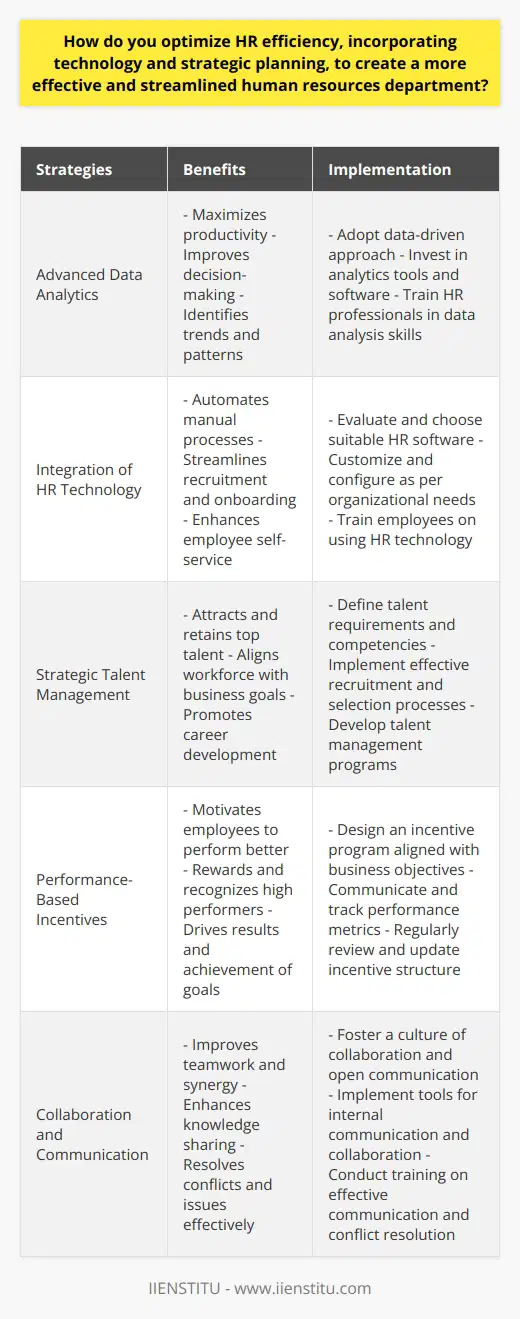
What is the key to success in HR, and what role do employee engagement and development play in achieving this success?
Understanding Success in HR
The key to success in human resources (HR) lies in maximizing human capital. This involves getting the best out of your employees and ensuring they remain engaged and satisfied in their roles. HR needs to be proactive in creating an environment that encourages employee growth and development.
Role of Employee Engagement
Employee engagement forms a crucial part of HR’s success. Engaged employees typically exert more effort, are more productive and are more likely to remain loyal to the company. They feel valued and connected to the organization's goals and vision. A sound employee engagement strategy cultivates a positive and vibrant work culture. This leads to higher levels of job satisfaction, increased productivity, and lower turnover rates.
Significance of Employee Development
Moreover, a company’s commitment to employee development significantly contributes to HR success. Continuous learning and development opportunities motivate employees, increase their skills, and improve their performance. Employee development builds a proficient workforce that can drive the company towards achieving its strategic goals. It also attracts and retains high-quality employees, ensuring the organization has talented individuals to meet its present and future needs.
In conclusion, employee engagement and development are not just about increasing productivity but also about creating a positive work environment. A successful HR strategy does more than drive individual performance, it cultivates a culture where employees feel valued, are motivated to grow, and are committed to supporting the company's vision. Therefore, to be successful, HR must prioritize employee engagement and development.

How do you measure the success of an HR team, considering both subjective and objective indicators, while taking into account the unique context of each organization?
Measuring HR Team Success
Success of an HR team is both a subjective and objective appraisal, requiring a multi-faceted approach. It involves considering both quantitative and qualitative parameters, exclusive to the organization.
Objective Indicators
Objective measurements come from tangible results. These include recruitment time, retention rates, and employee satisfaction scores. They offer statistical evidence directly linked to HR activities. Recruiting time, for instance, signifies efficiency in filling vacant positions. Retention rates reflect the effectiveness of HR in driving job satisfaction and employee engagement. Lastly, using regular surveys can quantify employees' perceptions, adding to the measurable evidence.
Subjective Indicators
Subjective indicators involve a level of interpretation, yet remain crucial. These consist of feedback from the team, organizational culture, and leadership appraisal. Feedback helps understand shortcomings and successes. Employees' opinions help evaluate the effectiveness of HR policies and processes. Organizational culture is more interpretive. A positive and inclusive culture suggests successful HR efforts. Leadership appraisals reflect the top management's perspective of the HR team's accomplishments.
Tailoring to Organizational Context
Customizing the assessment to unique organization traits is vital. Factors like industry, size, and culture influence HR roles and functions. For instance, in a small organization, the HR team's focus might be on recruitment and policy development. In a larger company, they might prioritize continuous learning and well-being programs. As such, indicators should align with the organization's goals and HR's roles.
By blending objective and subjective measurements, an accurate picture of HR's effectiveness emerges. Objective data offers hard evidence while subjective impressions provide invaluable insight. This holistic approach ensures alignment with unique organizational context, refining success measurements. It also highlights areas of improvement, fostering overall organizational growth.
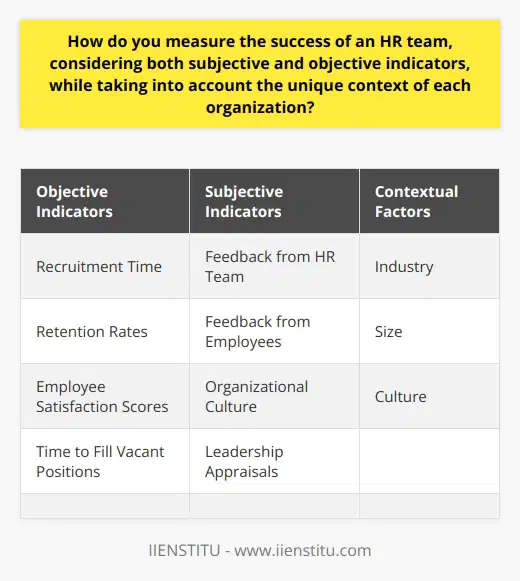
How do you optimize HR efficiency by balancing technology-driven solutions with personalized and proactive human engagement?
Effective Technological Engagement in HR
We can optimize HR efficiency by utilizing technology-driven solutions and human engagement harmoniously. For instance, HR specific technology helps automate routine tasks. By leveraging HR software, repetitive tasks like payroll processing, managing employee information and employment applications become less time consuming. Implementing software solutions also minimizes administrative workload and human error, making HR functions more efficient and accurate.
Promoting Personalized Engagement
Yet, a well-balanced approach ensures these technical deployments do not overshadow the essential human aspect of HR. Personalized and proactive human engagement plays a crucial role in retention and development of employees. It involves understanding individual employee needs, providing regular feedback, recognizing their contributions, and addressing concerns promptly. Face-to-face interactions, meetings and one-on-one sessions aid in fostering better employee relations, promoting a positive work environment.
Adopting a Hybrid Approach
Optimizing HR efficiency requires a delicate blend of both; an approach that pairs digital advancements with sensitive human touch. While technology strengthens HR’s operational efficiency, personal contact and engagement cater to emotional and psychological needs. This will not only streamline HR processes but also create an appreciative and engaged workspace where employees feel valued.
In conclusion, achieving HR efficiency is possible through tactical balancing of technology and human engagement. The technology simplifies processes, while human engagement preserves the essential interpersonal bond. The key is blending the efficiency of technology with the sensitivity of human touch, to create an HR system that is both high-performing and employee-friendly.
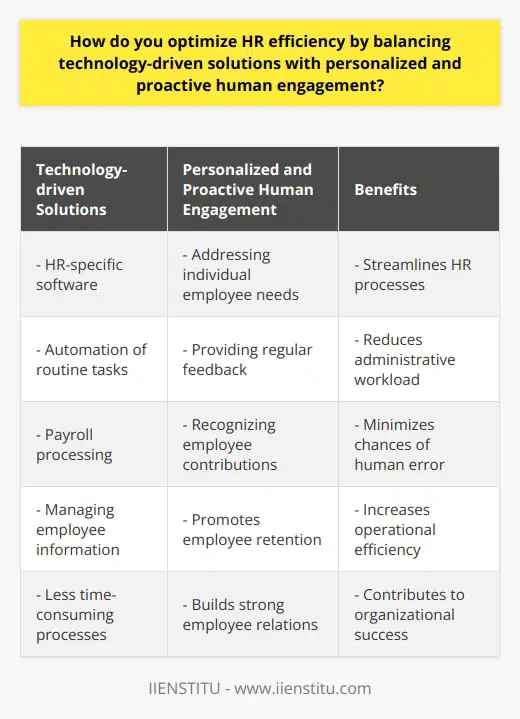
What is the ideal HR to staff ratio, and how can it be adjusted to account for differences in industry, workforce size, and organizational complexity?
Ideal HR to Staff Ratio
The ideal ratio of HR personnel to staff varies significantly across sects and organizations. In general, the notion of one HR staff member managing around 100 employees is popular, but it's not a blanket rule.
Industry idiosyncrasies
Industry peculiarities can have a substantial impact on the required HR to staff ratio. For instance, industries like hospitality or health care, which involve extensive interpersonal interactions and stringent regulatory protocols, may need more HR staff relative to the industries that are more tech-driven or that have less strict regulatory norms.
Workforce Size and HR Staffing
The size of the workforce also plays a crucial role in determining the HR to staff ratio. In smaller-sized organizations, one HR person might efficiently manage all HR tasks. Conversely, larger organizations, with more complicated hierarchies and substantially broader employee dynamics, tend to have higher HR to staff ratios.
Role of Organizational Complexity
Organizational complexity feeds into HR staffing decisions notably. Organizations with multifaceted structures, global operations, and diverse workforce, necessitate a well-staffed HR department to manage complex situations.
Conclusively, reassessing the ratio for precise tailoring to an organization's circumstances should be a recurrent process instead of a one-time activity. Flexible HR staffing strategies that accommodate changes in the industry, staff size, and organizational complexity can dramatically enhance overall HR functionality and effectiveness.
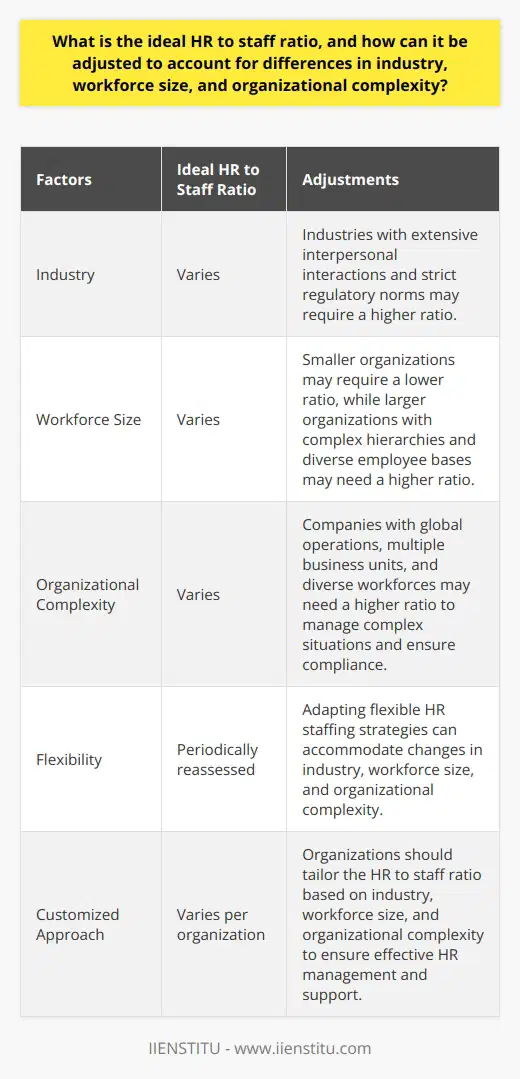
What is the key to success in HR, particularly in terms of fostering a positive workplace culture, boosting employee satisfaction, and promoting diversity and inclusion?
Developing a Positive Workplace Culture
The key to success in HR lies primarily in creating a positive workplace culture. A positive culture increases employees' job satisfaction while simultaneously enhancing their productivity levels. This requires HR teams to invest in a conducive work environment that appreciates employee contributions and encourages constructive feedback.
Enhancing Employee Satisfaction
Additionally, enhancing employee satisfaction also plays a crucial role in HR success. Employees who feel valued and satisfied with their job conditions will likely exhibit higher performance levels. Regular recognition, competitive remuneration, and opportunities for professional growth are excellent strategies to foster employee satisfaction.
Promoting Diversity and Inclusion
Furthermore, promoting diversity and inclusion is a critical aspect for HR success. A workforce representing diverse perspectives, backgrounds, and skills can foster creativity and innovation. HR should implement policies that advocate for equal opportunities regardless of gender, ethnicity, or sexual orientation. Training sessions on cultural competency, anti-discrimination, and inclusion can further promote a respectful and inclusive work environment.
In conclusion, fostering a positive workplace culture, boosting employee satisfaction, and promoting diversity and inclusion are key elements for HR success. These strategies require consistent attention and effort but yield significant benefits by improving employee morale, productivity and company's overall success.
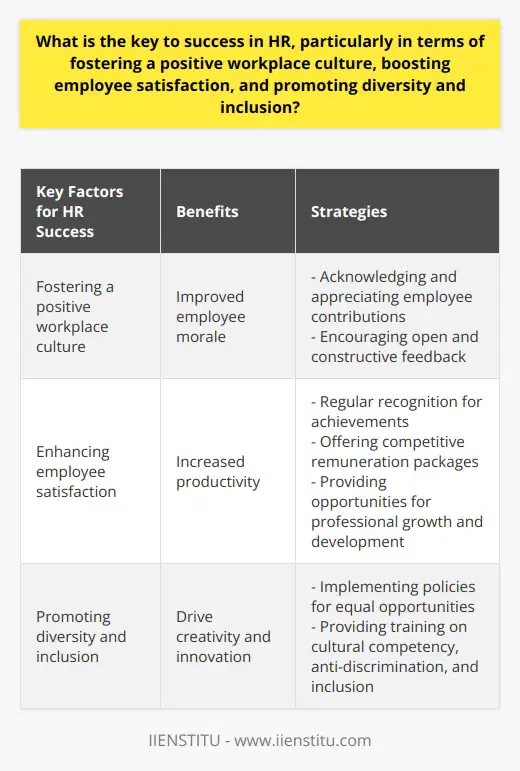
How do you measure the success of an HR team, taking into consideration both qualitative and quantitative metrics, and accounting for differences in organizational goals and values?
Measuring HR Success with Quantitative Metrics
Quantitative metrics provide a numerical basis for evaluating HR team success. Key Performance Indicators (KPIs) such as cost per hire, time to fill a position, turnover rate, and employee engagement score provide objective evidence of the HR team's effectiveness.
Analyzing Qualitative Metrics in HR Performance
On the other hand, qualitative metrics offer deeper insights into HR performance. Feedback from exit interviews, employee satisfaction surveys, and appraisal systems can paint a comprehensive picture of the HR team's success, despite their subjective nature.
Alignment with Organizational Goals and Values
Moreover, a true measure of HR success involves aligning HR activities with an organization's goals and values. The ability of the HR team to instil corporate culture, inspire employee loyalty towards organizational goals, and maintain a strong employer brand can serve as key indicators of their success.
The Balance between Quantitative and Qualitative Metrics
A balanced approach to measuring HR success would involve a harmonious blend of both qualitative and quantitative metrics. This ensures a holistic and comprehensive view of the HR team's success. However, the balance between these two types of metrics should reflect the organization's unique goals, values, and culture.
In conclusion, measuring the success of an HR team is a complex task that requires a combination of quantitative and qualitative metrics. Furthermore, these metrics must align with the organization's goals and values. Only then can a comprehensive, balanced, and fair assessment of the HR team's success be created.



